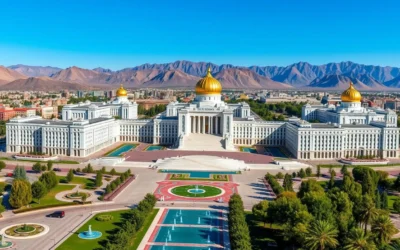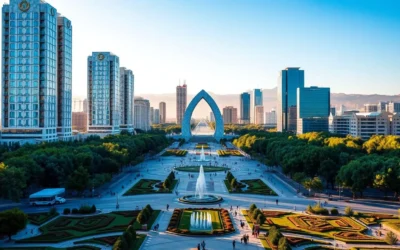✓ Accommodations✓ Flights✓ Rental Cars✓ Tours & Activities
Language plays a vital role in shaping the identity of a country. In Turkmenistan, this is especially true. The nation adopted Turkmen as its official language in 1991, marking a significant moment in its history. This change reflects the cultural pride and heritage of its people.
Turkmen is spoken by over 3 million people, making it the most widely used language in the region. Russian also holds importance, especially in urban areas, though its usage has declined in recent years. Minority languages like Uzbek and Kazakh add to the rich linguistic diversity of the country.
Understanding the linguistic landscape of Turkmenistan offers insight into its culture and governance. It’s a fascinating blend of tradition and modernity, deeply rooted in its history. Explore how language influences every aspect of life in this dynamic nation.
Introduction to Turkmenistan’s Linguistic Heritage
The linguistic heritage of this Central Asian nation reflects its rich history and culture. Over centuries, diverse ethnic groups have shaped its vibrant language landscape. The population includes Turkmens, Uzbeks, Russians, and others, each contributing to this unique blend.
Ethnic diversity plays a key role in the development of language here. For example, Turkmens make up 85% of the population, while Uzbeks and Russians account for 5% and 4%, respectively. This mix has created a fascinating interplay of dialects and traditions.
“Language is the roadmap of a culture. It tells you where its people came from and where they are going.”
Historical events have also left their mark. The shift from Arabic to Latin and Cyrillic scripts, and back to Latin, highlights the nation’s evolving identity. These changes reflect broader cultural and political shifts over time.
| Ethnic Group | Percentage of Population |
|---|---|
| Turkmen | 85% |
| Uzbek | 5% |
| Russian | 4% |
| Other | 6% |
Understanding this heritage offers insight into the nation’s identity. The language you hear today is a product of centuries of tradition and adaptation. It’s a testament to the resilience and creativity of its people.
Historical Overview of Turkmen Linguistic Evolution
From ancient tribes to modern times, the Turkmen language has undergone significant transformations. Its evolution reflects centuries of cultural shifts and historical events. Understanding this journey offers insight into the resilience and adaptability of its people.
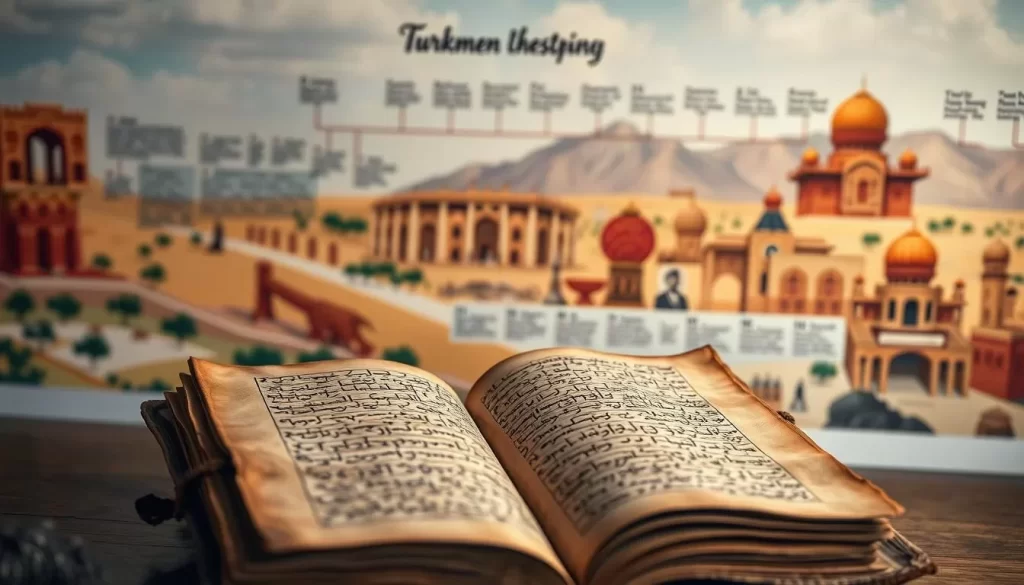
Ancient Influences and Early Traditions
The roots of the Turkmen language trace back to the Oghuz tribes, who migrated into Central Asia in the 8th century. These early Turkic groups laid the foundation for the linguistic traditions you see today. Their dialects and oral traditions became the cornerstone of Turkmen culture.
By the 10th century, the name “Turkmen” emerged in written sources, distinguishing those who accepted Islam from other groups. This period marked the beginning of a distinct linguistic identity. The influence of Persian and Arabic also began to shape the vocabulary and structure of the language.
The Impact of the Soviet Era
The Soviet Union brought dramatic changes to the linguistic landscape. In the 20th century, the Cyrillic script was introduced, replacing traditional scripts. This shift aimed to standardize the language and integrate it into the broader Soviet framework.
During this time, Russian became a dominant language in education and governance. However, Turkmen retained its cultural significance, especially in rural areas. The Soviet era’s policies left a lasting impact, shaping modern usage and script transitions.
Today, the legacy of these historical periods continues to influence the Turkmen language. From ancient tribes to the Soviet Union, each era has contributed to its unique evolution.
Turkmen: The Official Language of Turkmenistan
Turkmen stands as a cornerstone of cultural identity in its homeland. Adopted as the official language in 1991, it reflects the nation’s pride and heritage. Over 90% of the population considers it their mother tongue, making it a vital part of daily life.
Alphabet Transitions and Linguistic Characteristics
The Turkmen language has seen significant script changes over time. It shifted from Arabic to Cyrillic during the Soviet era and later adopted the Latin alphabet in 1996. This transition reflects broader cultural and political shifts.
Today, the Latin-based alphabet consists of 30 letters, including nine vowels and 21 consonants. This modern script supports the development of the language, making it accessible and adaptable for future generations.
Turkmen’s linguistic features are equally fascinating. It has six grammatical cases, five moods, and three tenses. These elements contribute to its complexity and richness. For example, verbs vary by person and number, adding depth to communication.
- Six grammatical cases: nominative, genitive, dative, accusative, ablative, locative.
- Five moods: indicative, dubitative, imperative, conditional, subjunctive.
- Three tenses: present, past, future.
Regional dialects also add diversity to the language. These variations highlight the cultural richness of different communities. Together, these features make Turkmen a vibrant and evolving language.
Russian as a Secondary Language in Urban Centers
In urban areas, Russian remains a key language for communication, though its prominence has shifted over time. Once dominant in cities like Ashgabat, it now serves as a secondary language for around 12% of the population. This change reflects broader cultural and policy shifts.
Urban Influence and Shifts Over Time
Historically, Russian was widely used in media, including newspapers and television. Today, its role has diminished, with Turkmen taking precedence in most public spaces. However, Russian still plays a part in business and education, especially among older generations.
In the 1990s, Russian and Turkmen were nearly equal in everyday use. Over time, this balance has shifted, with Turkmen becoming the preferred language for most urban residents. This trend is particularly noticeable among younger people, who often use Russian only in specific contexts.
“Language is not just a means of communication; it’s a reflection of identity and history.”
Russian’s decline is also evident in rural areas, where it is rarely spoken. Urban centers, however, still see its use in certain media and professional settings. This duality highlights the complex role of Russian in modern society.
| Language | Percentage of Speakers |
|---|---|
| Turkmen | 72% |
| Russian | 12% |
| Uzbek | 9% |
| Other | 7% |
Understanding these shifts offers insight into the evolving linguistic landscape. Russian’s role may have changed, but its influence remains a part of urban life.
Minority Languages and Their Cultural Impact
Multilingualism is a defining feature of life in this part of Central Asia. While the majority speaks Turkmen, minority languages like Uzbek, Kazakh, and Tatar add depth to the cultural landscape. These languages are more than just tools for communication—they are symbols of identity and heritage.
Uzbek and Other Regional Linguistic Communities
Uzbek is one of the most prominent minority languages, spoken by around 9.1% of the population. Communities along the border areas often use Uzbek in daily life, preserving their cultural roots. This is especially true in regions where Uzbek populations are concentrated.
Kazakh and Tatar speakers also contribute to the linguistic diversity. Though smaller in number, these groups maintain their languages through family traditions and local gatherings. This persistence highlights the importance of cultural preservation in a rapidly changing world.
“A people’s language is their most precious heritage—it carries their history, values, and dreams.”
Despite Turkmen being mandatory in schools, many communities continue to teach their children native tongues at home. This practice ensures that minority languages remain alive and relevant. It’s a testament to the resilience of these cultural groups.
Understanding the role of minority languages offers insight into the region’s identity. It’s a reminder that diversity is not just about numbers—it’s about the stories, traditions, and connections that shape a community.
Language Diversity in Education and Media
Education and media play a pivotal role in shaping the linguistic landscape of a nation. In schools, the curriculum emphasizes the official language, ensuring it becomes the primary mode of communication. This approach helps standardize the language while preserving cultural identity.
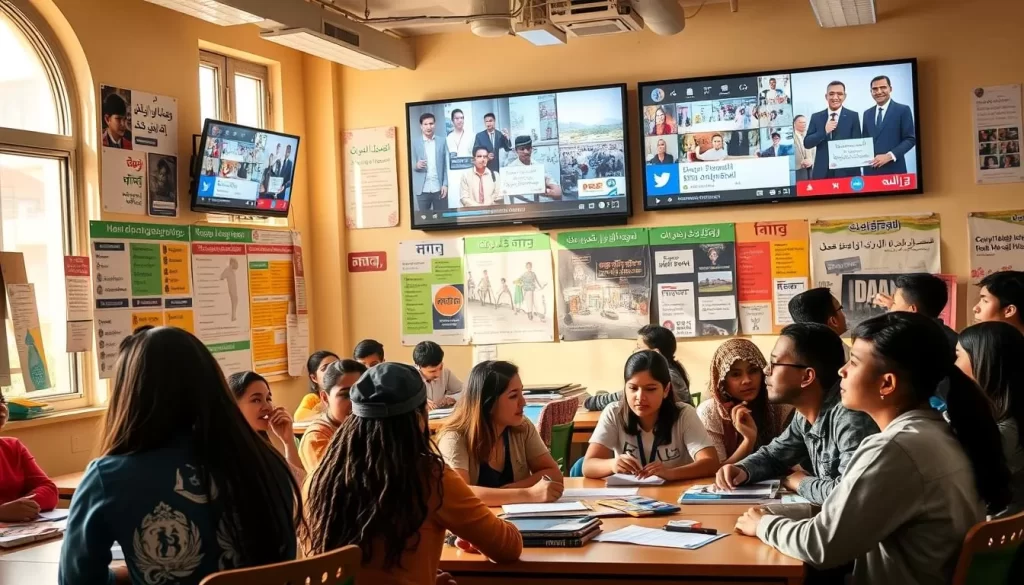
Government institutions mandate the use of the official language in educational settings. This policy ensures that students develop fluency and literacy in their native tongue. However, minority languages and Russian are also taught, reflecting the nation’s commitment to diversity.
Media outlets further reinforce this linguistic framework. Newspapers, television, and radio programs predominantly use the official language. This widespread usage normalizes its presence in daily life, fostering a sense of unity and pride.
“Media is not just a mirror of society; it’s a tool for shaping its future.”
Despite these efforts, challenges remain. Some regions face difficulties in implementing standardized language education due to resource constraints. Reforms are ongoing to address these issues, ensuring equitable access to quality education for all.
- Schools prioritize the official language in their curricula.
- Media outlets use the official language to promote cultural identity.
- Government institutions support linguistic diversity through inclusive policies.
Understanding the role of education and media in language diversity offers insight into the nation’s cultural priorities. It’s a testament to the power of communication in shaping identity and fostering unity.
Turkmenistan: Official and widely spoken languages
The linguistic framework of this nation is shaped by its official policies and cultural diversity. The government mandates the use of Turkmen in all legal and administrative documents, reinforcing its status as the primary mode of communication. This policy ensures consistency across institutions while preserving cultural identity.
Turkmen is spoken by 72% of the population, making it the most prevalent language in the region. Russian, though secondary, remains significant in urban centers, especially among older generations. Minority languages like Uzbek and Kazakh add richness to the linguistic landscape, reflecting the nation’s ethnic diversity.
Legal requirements play a crucial role in maintaining this balance. For example, the 1992 constitution established Turkmen as the official language of inter-ethnic communication. This ensures that all communities can engage effectively with government institutions. Such policies highlight the importance of linguistic unity in a diverse society.
“Language is not just a tool for communication; it’s a bridge that connects communities and cultures.”
The coexistence of official and secondary languages reflects the nation’s commitment to inclusivity. While Turkmen dominates public spaces, Russian and minority tongues thrive in specific contexts. This balance ensures that cultural heritage is preserved while fostering national unity.
- Turkmen is the primary language for 72% of the population.
- Russian is widely used in urban areas, particularly among older generations.
- Minority languages like Uzbek and Kazakh contribute to cultural diversity.
Understanding this linguistic landscape offers insight into the nation’s identity. It’s a testament to the power of language in shaping culture, governance, and community connections.
Language Policy and Government Institutions
The government plays a central role in shaping how language is used across public and private sectors. Through strict policies, it ensures that the official language remains the primary mode of communication in schools, media, and official settings. This approach helps maintain cultural identity while fostering national unity.
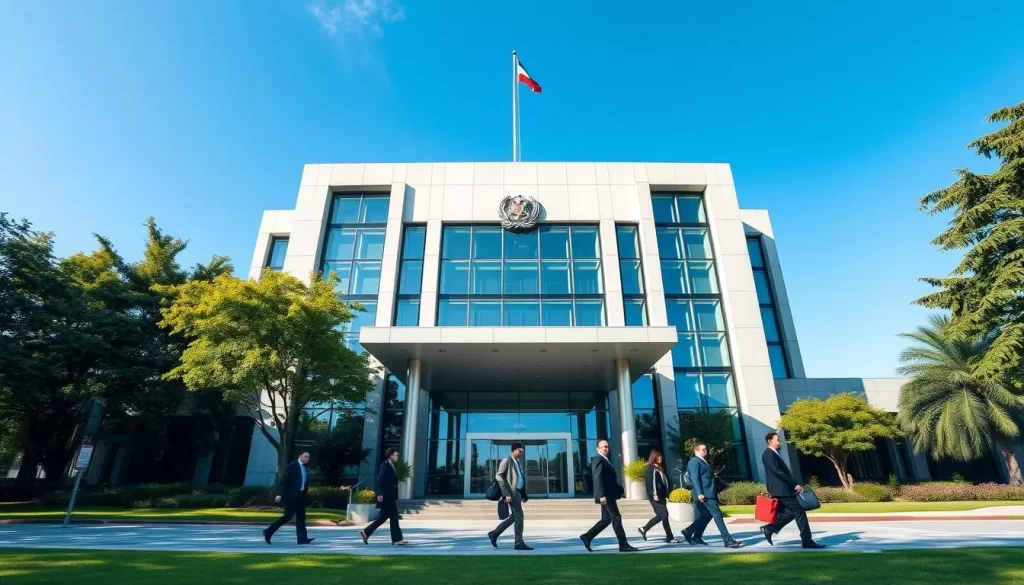
Institutions enforce these policies to create order in language use. For example, the official language is mandatory in all legal and administrative documents. This ensures consistency across government bodies and reinforces its importance in daily life.
Reforms have been implemented over time to adapt to changing needs. In 1991, the official language was declared the sole medium of instruction in schools. This decision aimed to strengthen its role in education while preserving cultural heritage.
“Language policies are not just rules; they are tools for preserving identity and fostering unity.”
Legal mandates also play a crucial role. The constitution ensures that the official language is used in inter-ethnic communication. This policy allows all communities to engage effectively with government institutions, promoting inclusivity.
Understanding these policies offers insight into how language shapes society. It’s a testament to the power of government in preserving culture and fostering unity through clear and consistent language use.
Preserving Dialects and Regional Variations
Dialects are the heartbeat of cultural identity, preserving the unique voices of communities across regions. They carry the essence of local traditions, history, and daily life. In many areas, these variations are more than just ways of speaking—they are symbols of heritage and belonging.
Efforts to document and sustain dialects are critical. Every word and number recorded helps keep these linguistic treasures alive. Without such efforts, the rich diversity of regional speech could fade away, taking centuries of culture with it.
Teke Dialect Features and Preservation Efforts
The Teke dialect forms the foundation of the standardized language used today. It is known for its distinct pronunciation and vocabulary, setting it apart from other regional variations. Linguists have worked tirelessly to document its unique features, ensuring its preservation for future generations.
In rural areas, the Teke dialect remains widely spoken, serving as a vital link to cultural roots. Preservation efforts include recording oral traditions and teaching younger generations. These initiatives highlight the importance of every word in maintaining linguistic identity.
Other Dialects Across Rural and Urban Areas
Beyond the Teke dialect, other regional variations add depth to the linguistic landscape. In urban areas, dialects often blend with mainstream speech, creating unique hybrid forms. In contrast, rural areas tend to preserve older, more traditional dialects.
Challenges in preserving these dialects include limited resources and shifting demographics. However, linguists and government institutions are working together to document them. Their efforts ensure that even the smallest area contributes to the broader cultural mosaic.
“Preserving dialects is not just about saving words; it’s about safeguarding the stories and identities they carry.”
Understanding these regional variations offers insight into the nation’s cultural richness. It’s a reminder that every dialect is a piece of the larger puzzle, contributing to the vibrant tapestry of human expression. For more on preserving endangered languages, visit this resource.
Linguistic Connections within the Turkic Family
The Turkic language family connects millions across Eurasia through shared roots and mutual intelligibility. With 23 different languages, this family spans from Turkey in the West to China and Siberia in the East. Turkmen, a member of the Oghuz branch, shares close ties with Turkish, Azerbaijani, and Crimean Tatar.

You’ll notice similarities in vocabulary and grammar among these languages. For example, the word for “one” is “bir” in Turkmen, Turkish, and Azerbaijani. These shared elements make it easier for speakers of one Turkic language to understand another, fostering cultural and historical connections.
The family ties go beyond just words. The Oghuz branch, which includes Turkmen, is one of six groups within the Turkic language family. This grouping highlights the deep-rooted unity among these languages, despite their regional differences.
“Language is the roadmap of a culture. It tells you where its people came from and where they are going.”
Understanding these connections offers insight into the broader family of Turkic languages. It’s a reminder of how language can bridge cultures and histories, creating a sense of shared identity. For more on the Turkic languages, explore their rich history and evolution.
Cultural Identity and Heritage through Language
Cultural identity is deeply rooted in the way people communicate and express themselves. In this part of the world, the language you speak is more than just words—it’s a reflection of your history, tradition, and connection to your tribe. From ancient times to the present, it has shaped who you are and how you see the world.
Literature and poetry play a vital role in preserving this identity. Figures like Magtymguly Pyragy have used their words to capture the essence of their culture. Their works are not just stories; they are a bridge between generations, keeping traditions alive.
Historical influences from well-known tribes like the Teke and Ýomut have left a lasting mark on the language. These groups have shaped the way people speak today, creating a rich tapestry of dialects and expressions. Each word carries the weight of centuries of history.
“Language is the soul of a people. It carries their dreams, their struggles, and their triumphs.”
Daily communication also reinforces this identity. Whether it’s through music, public rituals, or simple conversations, the language you use connects you to your community. It’s a reminder of where you come from and who you are as a person.
For more on how cultural identity in Turkmenistan is shaped by language, explore the deep connections between heritage and communication.
The Role of Language in Modern Central Asian Society
In the heart of Central Asia, language serves as a bridge between tradition and modernity. It connects people to their roots while adapting to the demands of a rapidly changing world. Whether through spoken words or written texts, it plays a vital role in shaping community bonds and fostering cultural exchange.
Communication and Community Influence
Language is more than just a tool for communication; it’s a reflection of identity. In Central Asia, it helps preserve cultural heritage while enabling dialogue across diverse groups. For example, social media platforms have become spaces where traditional and modern expressions coexist.
Traditional media, such as newspapers and radio, continue to play a significant role. They reinforce the use of native languages while introducing new ideas. This blend of old and new ensures that language remains relevant in daily life.
“Language is the thread that weaves communities together, connecting the past to the present.”
Modern communication tools have also influenced how people interact. Social media platforms like Instagram and Facebook allow users to share stories in their native tongues. This fosters a sense of belonging while promoting cultural pride.
Understanding the role of language in modern society offers insight into its power. It’s not just about words; it’s about building connections and preserving identity. For more on how language shapes politics and culture in Central Asia, explore this resource.
| Media Type | Influence on Language Use |
|---|---|
| Social Media | Promotes native languages and cultural exchange |
| Traditional Media | Reinforces standard language practices |
| Educational Platforms | Encourages bilingualism and modern communication |
Language continues to evolve, reflecting the dynamic nature of Central Asian society. It’s a testament to the resilience of its people and their ability to adapt while staying true to their roots.
Language Modernization in the Post-Independence Era
The post-independence era marked a transformative period for language modernization in the region. After gaining independence in 1991, significant reforms were implemented to reshape the linguistic landscape. These changes aimed to strengthen cultural identity and align with global standards.
Transitioning from Cyrillic to Latin Script
One of the most notable reforms was the transition from Cyrillic to Latin script. This shift began in the early 1990s and was completed by 2000. The new alphabet aimed to simplify writing and promote national identity.
The Latin script was chosen to reflect the region’s historical roots and to facilitate international communication. This change was part of a broader effort to modernize the state’s linguistic framework.
Education Reforms and Media Development
Education reforms played a crucial role in this modernization process. Schools adopted the new script, ensuring that younger generations grew up fluent in the updated language. This approach helped maintain order in the transition process.
Media development also supported these changes. Television, radio, and newspapers began using the Latin script, normalizing its use in daily life. This shift was essential for reinforcing the new linguistic standards.
“Language modernization is not just about changing scripts; it’s about preserving identity while embracing progress.”
These reforms were implemented over several years, ensuring a smooth transition. The systematic approach helped maintain cultural continuity while adapting to modern needs.
For more on the linguistic landscape of the region, explore how these changes have shaped its identity.
Conclusion
The role of language in shaping a nation’s identity cannot be overstated. It connects people to their roots while fostering unity in a diverse society. Throughout history, regional factors like proximity to the Caspian Sea have influenced linguistic evolution, adding depth to cultural heritage.
Different tribes have played a key role in shaping this identity. Their traditions and dialects continue to influence daily life, ensuring that cultural richness remains at the center of national development. This blend of tradition and modernity highlights the importance of maintaining order in language policy.
Today, language remains a vital part of governance and everyday interactions. Its impact is evident in education, media, and even national news. By preserving this heritage, the nation ensures its cultural and linguistic future thrives. Explore more about its unique cultural features to understand its rich identity.
The above is subject to change.
Check back often to TRAVEL.COM for the latest travel tips and deals.


